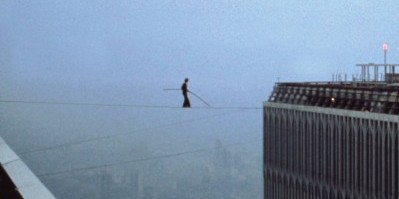By contributor Spencer Wilson
When first hearing about Man on Wire, it’s hard to imagine this will be an entertaining or engaging film. And yet, the documentary about Philippe Petit’s 1974 high-wire walk between the Twin Towers manages to not only be a great film, but one of the best documentaries of all time.
Petit begins by telling us an experience he had as a young boy while waiting to see the dentist about a toothache. While sitting in the waiting room, he sees an ad in a magazine for the building on the Twin Towers of New York’s World Trade Center. Overcome with the desire to high-wire walk between the towers, he decides to skip his appointment so he can swipe the magazine to hang onto his “dream and obsession.” By this time, it was 1968 and Petit was 17. At the age of 16, Petit had already taught himself how to high-wire walk and how to do every trick possible on the wire. This led to a couple of illegal, high-profile, and risky high-wire performances between the towers of the Notre Dame Cathedral in 1971 and across the Sydney Harbour Bridge in 1973.
In between those times, Petit and his cohorts worked for six years on how to pull off a high-wire walk between the Twin Towers. The documentary is very much narrative-driven, with interviews from Petit and those associated with the stunt, as well as Petit reading passages from his book To Reach the Clouds, driving the story and themes of inspiration. The footage switches between masterful uses of Ken Burns’ Effect photo shots, footage of Petit practicing and organizing the stunt with his friends, and staged scenes depicting how the stunt was executed. The staged scenes are what really help the movie tie everything together.
Obviously, not every aspect of the operation could have been captured on film, but James Marsh’s objective portrayal of the interview stories brings life to what was happening. In a way, the operation part turns the film into a fantastical crime film, which is how Petit describes feeling about the operation in the days leading up to its execution. Even though we know that Petit succeeds, the film’s excellent build-up of tension makes it feel like there is a sense of danger, making the victory that much more satisfying to witness.
The most amazing aspect of Man on Wire is that James Marsh manages to hide his own take on Petit’s life inside the film. When we are first introduced to Petit, we are given footage of him surrounded by his friends, and everyone being interviewed talks about having the same dream of helping Petit pull off this stunt. Once the stunt is over, there is suddenly a disconnect between Petit and the rest of the group—one that is so strong that it makes one of the main conspirators, Jean-Louis Blondeau, cry during the interview over that loss of friendship. Now famous, Petit is depicted in the company of very few, and at the end of the film, alone. Hidden within Petit’s messages to follow your dreams is the warning of what might happen to those who are not ready for fame.
Man on Wire took home the Academy Award for Best Documentary in 2009, and rightfully so. The film showcases a lot of James Marsh’s strengths, which are not as evident in The Theory of Everything. It is a wonderfully unique and beautiful documentary experience, and one that any person should take the time to watch.
Other great documentaries:
- Senna, 2010 Bafta Winner (on Netflix)
- Searching for Sugar Man, 2013 Oscar Winner (on Netflix)
- The Imposter, 2013 Bafta Winner (on Netflix)
- Citizenfour, 2015 Oscar Winner
Other Essential Viewings:

